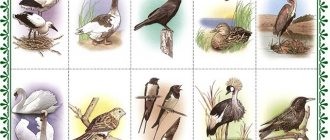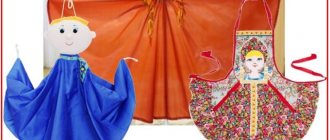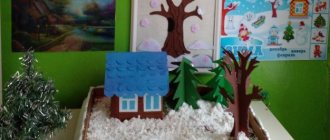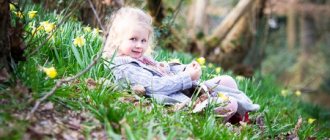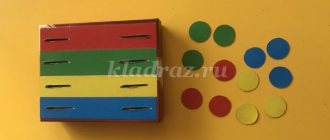Summary of a lesson on cognitive development in the first junior group “Friends of Nature”
Tatiana Kalnitskaya
Summary of a lesson on cognitive development in the first junior group “Friends of Nature”
Summary of a lesson on cognitive development in junior group 1 “Friends of Nature.”
Goal: to form in children a conscious, correct attitude towards nature.
Tasks:
1) teach the basics of interaction with nature, rules of conduct in the forest; shape the perception of color.
2) develop cognitive interest, motor activity, speech breathing.
3) cultivate a caring attitude towards nature and responsiveness.
Equipment: colored mats, colored tickets, paper petals and flower centers, twigs, trash bag, “garbage”, audio recording, tree models.
Progress of the lesson.
Educator. Children, today I propose to go to the forest: listen to the birds singing, admire the flowers and trees. You want?
Children. Yes.
Educator . We will travel on carpeted airplanes. Grab your tickets and take your seats.
Children sit on colored mats, matching the colors of the ticket and the mat. Music is playing.
Educator . Here we are. Where are we?
Children. In the forest.
Educator. You can’t hear the birds singing and there are no animals. It's strange that something happened, I guess.
Amanita appears.
Fly agaric. I am Grandfather Fly Agaric. Where did you come from and why?
Children. We are from kindergarten.
Educator. We came to the forest to breathe fresh air, listen to the birds singing, see what grows in the forest, who lives in the forest. Something is quiet in your forest, Grandfather Fly Agaric, where has everyone gone?
Fly agaric . Children from kindergarten came to us, scattered garbage throughout the forest, picked flowers, destroyed bird nests, screamed very loudly... The animals and birds got scared and left the forest, I was left alone.
Educator. Grandfather Fly Agaric, what needs to be done to bring everyone back?
Fly agaric. It is possible to help. Look, here in the clearing there were flowers growing, and butterflies and bees were flying above them. The children picked the flowers and the butterflies flew away. To bring them back, you need to collect flowers.
Educator . Children, can we help you pick flowers?
Children. Yes, we will help.
Game "Collect flowers".
Children must choose petals of the same color as the center and fold the flower.
Educator . What should we do next?
Fly agaric . The bad guys threw rocks at the birds' nests and destroyed them. Now the birds have nowhere to live.
Educator. Children, is it possible to offend birds?
Children. No you can not.
Educator. For whom do birds make their nests?
Children. For chicks.
Educator. That's right, birds make their nests for little chicks. To do this, they collect a lot of twigs. I suggest making a nest of twigs. What shape is a bird's nest? What is a bird's nest made of?
Children. The nest is round. Birds build it from twigs.
An audio recording of “Birdsong” is played. Children build a nest.
Educator. It seems the birds are returning. Now they have a nest. Thank you.
Fly agaric . Well done guys, But you still need to collect the trash.
Educator . Let's put the garbage in a special bag, and when we return to kindergarten, throw it in a garbage container.
Game "Collect garbage".
Educator. What order is there now in the forest! Immediately the air became fresh and clean. Let's breathe this air.
Breathing exercises to the audio recording “The Sound of the Forest.”
Inhale deeply through your nose and exhale slowly through your mouth.
Educator. Children, how will we behave in the forest?
Children. Fine. Let's not offend the birds, make noise, or pick flowers.
Educator. We understand everything and will behave correctly in the forest. Goodbye friends. It's time for us to go home, we're boarding the planes.
Music is playing.
Educator . Here we are at home. Where were the children? Who did you see? What they were doing?
Educational field: Child and nature
Form ideas: – about the characteristics of plants as living beings: they move, turn leaves, stems, flowers towards the sun, open and close petals, etc.; feed (the root absorbs water from the ground, the stem conducts water and food to other parts of the plant, the leaves catch light and nourish the plant); breathe leaves, stem (trunk), roots; “feel” the arrival of heat, cold, sunny or cloudy weather, etc.; grow and multiply; – methods of caring for plants in accordance with their needs: watering, loosening, removing dust from the leaf plate, weeding, sowing, planting, spraying, propagating plants (leaf and stem cuttings, mustaches); – the need to comply with the rules of behavior in the process of interaction with indoor plants and plants in the natural environment. Develop skills: – recognize and name 5–7 types of indoor plants (Tradescantia, amaryllis, Decembrist, ivy, indoor grapes, etc.), trees and shrubs (poplar, ash, jasmine, hazel, apple, pear, cherry, etc.), flowering plants (peony, dahlia, chrysanthemum, primrose, etc.), vegetables (carrots, tomatoes, potatoes, lettuce, dill, parsley, onions, garlic, etc.), weeds (quinoa, wheat grass, chickweed, etc.) , grain crops (rye, wheat, etc.), forest berries (lingonberries, blueberries, cranberries, etc.), mushrooms (boletus, aspen, russula, honey mushrooms, boletus, etc.), plants listed in the Red Book of the Republic of Belarus ( white water lily, yellow water lily, dream grass, lungwort, etc.); plants of hot countries and their fruits (palm, pineapple, orange, pomegranate, kiwi, peach, apricot, banana, etc.); – determine in the process of observation, experimentation and labor the functions of plant organs: roots absorb water and nutrients from the soil, hold the plant in the soil, breathe; stems transmit water, nutrients, hold branches, leaves, flowers, fruits; leaves absorb light, breathe, evaporate moisture; flowers breathe, bloom, form seeds; seeds contribute to the emergence of a new plant; – group plants according to different characteristics: life form (grass, bush, tree), leaf structure (deciduous, coniferous), relationship to humans (cultivated, wild), method of use (food, medicinal, ornamental), place of growth (forest, meadow plants, pond plants, garden plants, field plants, vegetable garden plants, flower garden plants); – characterize seasonal changes in the plant world: in the fall, leaves gradually color and fall, grass withers, crops ripen, people harvest in fields, vegetable gardens, orchards; in winter, trees and bushes without leaves do not grow because the necessary conditions are not available (no heat, water, loose soil, not enough light); in the spring the necessary conditions for plant growth appear, the buds swell, leaves and grass appear, flowers bloom first in sunny meadows, then in shaded places, in the summer the plants grow, bloom, bear fruit, as they have the necessary conditions; – correlate the state of plants with seasonal changes in inanimate nature. To educate: responsibility for the condition of plants in the immediate environment; desire to actively participate in nature conservation.
Abstract of GCD in junior group 1 on the topic: Walk through the autumn forest
Lesson in the first junior group “Walk through the autumn forest.
Visit the Hedgehog" GOAL: 1. To introduce children to the features of living nature. 2. Learn to understand the behavior and habits of animals. 3. Cultivate an interest in nature, a kind attitude towards all living things. 4. Expand your understanding of the lifestyle of wild animals in the fall (how they prepare for winter). 5. Strengthen the ability to compose various phrases and short simple sentences. VOCABULARY: 1. Fly agaric;
2. White mushroom; 3. Leaf fall; 4. Edible, inedible; 5. Yellow, green, red; 6. Cloudy, cold, golden autumn. PROGRESS OF THE CLASS
The group is decorated with autumn leaves (yellow, red, green).
The teacher asks a riddle. Educator: Guys, I’m now going to tell you a riddle, and you listen carefully. If the leaves on the trees have turned yellow, If birds have flown to a distant land, If the sky is gloomy, if it is raining. This time of year, what is it called? (Autumn) Children: Autumn. Educator: Do you want to go visit the mistress of autumn? How to find the way? Look, maybe autumn has left us its clues? Leaves were laid out and hung along the way. There are environmental posters hanging on the walls (bugs, nest, lily of the valley, anthill, stream). Children enter the group.
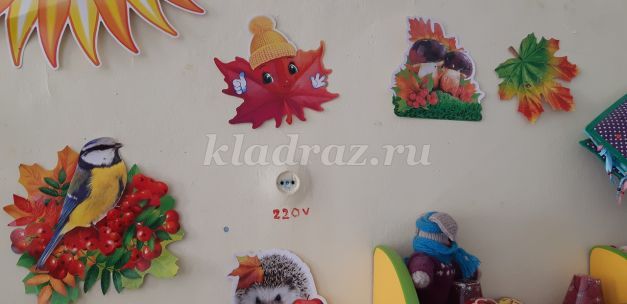
We recommend watching:
Summary of a lesson on speech development for the 2nd junior group. Pleshcheev “Autumn” Summary of OOD in the junior group with presentation. A Journey to the Autumn Forest Notes on social and communicative development in the 2nd junior group on the topic: Autumn Notes on social and communicative development in the 2nd junior group on the topic “Autumn has come to us”
Similar articles:
Lesson notes for the younger group. Broken applique “Autumn leaves”
